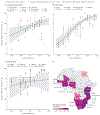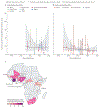Trends in HIV testing, the treatment cascade, and HIV incidence among men who have sex with men in Africa: a systematic review and meta-analysis
- PMID: 37453439
- PMCID: PMC11403132
- DOI: 10.1016/S2352-3018(23)00111-X
Trends in HIV testing, the treatment cascade, and HIV incidence among men who have sex with men in Africa: a systematic review and meta-analysis
Erratum in
-
Correction to Lancet HIV 2023; 10: e528-42.Lancet HIV. 2025 Jul 30:S2352-3018(25)00228-0. doi: 10.1016/S2352-3018(25)00228-0. Online ahead of print. Lancet HIV. 2025. PMID: 40752503 No abstract available.
Abstract
Background: Gay, bisexual, and other men who have sex with men (MSM) are disproportionately affected by HIV. In Africa, MSM face structural barriers to HIV prevention and treatment that increase their vulnerability to HIV acquisition and transmission, and undermine the HIV response. In this systematic review, we aimed to explore progress towards increases in HIV testing, improving engagement in the HIV treatment cascade, and HIV incidence reductions among MSM in Africa.
Methods: We searched Embase, MEDLINE, Global Health, Scopus, and Web of Science for cross-sectional and longitudinal studies reporting HIV testing, knowledge of status, care, antiretroviral therapy (ART) use, viral suppression, and HIV incidence among MSM in Africa published between Jan 1, 1980, and March 3, 2023. We pooled surveys using Bayesian generalised linear mixed-effects models, used meta-regression to assess time trends, and compared HIV incidence estimates among MSM with those of all men.
Findings: Of 9278 articles identified, we included 152 unique studies published in 2005-23. In 2020, we estimate that 73% (95% credible interval [CrI] 62-87) of MSM had ever tested for HIV. HIV testing in the past 12 months increased over time in central, western, eastern, and southern Africa (odds ratio per year [ORyear] 1·23, 95% CrI 1·01-1·51, n=46) and in 2020 an estimated 82% (70-91) had tested in the past 12 months, but only 51% (30-72) of MSM living with HIV knew their HIV status. Current ART use increased over time in central and western (ORyear 1·41, 1·08-1·93, n=9) and eastern and southern Africa (ORyear 1·37, 1·04-1·84, n=17). We estimated that, in 2020, 73% (47-88) of all MSM living with HIV in Africa were currently on ART. Nevertheless, we did not find strong evidence to suggest that viral suppression increased, with only 69% (38-89) of MSM living with HIV estimated to be virally suppressed in 2020. We found insufficient evidence of a decrease in HIV incidence over time (incidence ratio per year 0·96, 95% CrI 0·63-1·50, n=39), and HIV incidence remained high in 2020 (6·9 per 100 person-years, 95% CrI 3·1-27·6) and substantially higher (27-199 times higher) than among all men.
Interpretation: HIV incidence remains high, and might not be decreasing among MSM in Africa over time, despite some increases in HIV testing and ART use. Achieving the UNAIDS 95-95-95 targets for diagnosis, treatment, and viral suppression equitably for all requires renewed focus on this key population. Combination interventions for MSM are urgently required to reduce disparities in HIV incidence and tackle the social, structural, and behavioural factors that make MSM vulnerable to HIV acquisition.
Funding: US National Institutes of Health, UK Medical Research Council, Canadian Institutes of Health Research, and Fonds de Recherche du Québec-Santé.
Translation: For the French translation of the abstract see Supplementary Materials section.
Copyright © 2023 The Author(s). Published by Elsevier Ltd. This is an Open Access article under the CC BY 4.0 license. Published by Elsevier Ltd.. All rights reserved.
Conflict of interest statement
Declaration of interests JS is supported by a doctoral award from the Fonds de recherche du Québec-Santé (FRQ-S). MM-G's research programme is funded by a Canada Research Chair (Tier 2) in Population Health Modeling and his research programme is funded by the Canada Research Chairs Program and Canadian Institutes of Health Research (CIHR). MM-G and JS report contracts with UNAIDS, outside the submitted work. MM-G reports support for meetings from UNAIDS, outside the submitted work. M-CB acknowledges funding from the HPTN Modelling Centre, which is funded by the US National Institutes of Health (UM1 AI068617) through HPTN. KG reports postdoctoral fellowship awards from the FRQ-S and the CIHR Canadian HIV Trials Network, outside the submitted work. KMM reports consulting fees from the University of North Carolina, and payments from Pfizer for teaching, all outside the submitted work. NK is supported by a career award from the FRQ-S (Junior 1), and reports grants from the CIHR, Canadian Network on Hepatitis C, the Public Health Agency of Canada, the McGill Interdisciplinary Initiative in Infection and Immunity, and Gilead Sciences, advisory fees from Gilead Sciences, ViiV Healthcare, Merck, and AbbVie, speaker fees from Gilead Sciences, AbbVie, and Merck, and participation in the Data Safety Monitoring Committee of the CIHR Canadian HIV Trial Network, all outside the submitted work. JL reports grants from Unitaid and ANRS|MIE, consulting fees from Inserm, presidency of the scientific committee of ANRS|MIE evaluating projects submitted for funding, and membership of a scientific committee at Inserm, all outside the submitted work. All other authors declare no competing interests.
Figures







Comment in
-
Gradual improvements in HIV outcomes for African GBMSM.Lancet HIV. 2023 Aug;10(8):e490-e492. doi: 10.1016/S2352-3018(23)00149-2. Epub 2023 Jul 12. Lancet HIV. 2023. PMID: 37453438 No abstract available.
References
-
- UNAIDS. In danger: UNAIDS global AIDS update 2022. Jul 27, 2022. https://www.unaids.org/en/resources/documents/2022/in-danger-global-aids... (accessed March 15, 2023).
-
- Mendos LR, Botha K, Lelis RC, de la Peña EL, Savelev I, Tan D. State-sponsored homophobia 2020: global legislation overview update. Geneva: ILGA, 2020.
-
- UNAIDS. Global AIDS Strategy 2021–2026—end inequalities. End AIDS. Geneva, Switzerland, 2021. https://www.unaids.org/en/resources/documents/2021/2021-2026-global-AIDS... (accessed March 15, 2023).
Publication types
MeSH terms
Grants and funding
LinkOut - more resources
Full Text Sources
Medical
Miscellaneous

